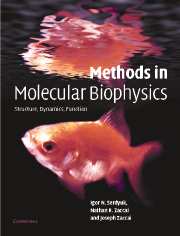Book contents
- Frontmatter
- Contents
- Foreword by D. M. Engelman
- Foreword by Pierre Joliot
- Preface
- Introduction: Molecular biophysics at the beginning of the twenty-first century: from ensemble measurements to single-molecule detection
- Part A Biological macromolecules and physical tools
- Part B Mass spectrometry
- Part C Thermodynamics
- Part D Hydrodynamics
- Part E Optical spectroscopy
- Part F Optical microscopy
- Part G X-ray and neutron diffraction
- Chapter G1 The macromolecule as a radiation scattering particle
- Chapter G2 Small-angle scattering
- Chapter G3 X-ray and neutron macromolecular crystallography
- Part H Electron diffraction
- Part I Molecular dynamics
- Part J Nuclear magnetic resonance
- References
- Index of eminent scientists
- Subject Index
Chapter G1 - The macromolecule as a radiation scattering particle
from Part G - X-ray and neutron diffraction
Published online by Cambridge University Press: 05 November 2012
- Frontmatter
- Contents
- Foreword by D. M. Engelman
- Foreword by Pierre Joliot
- Preface
- Introduction: Molecular biophysics at the beginning of the twenty-first century: from ensemble measurements to single-molecule detection
- Part A Biological macromolecules and physical tools
- Part B Mass spectrometry
- Part C Thermodynamics
- Part D Hydrodynamics
- Part E Optical spectroscopy
- Part F Optical microscopy
- Part G X-ray and neutron diffraction
- Chapter G1 The macromolecule as a radiation scattering particle
- Chapter G2 Small-angle scattering
- Chapter G3 X-ray and neutron macromolecular crystallography
- Part H Electron diffraction
- Part I Molecular dynamics
- Part J Nuclear magnetic resonance
- References
- Index of eminent scientists
- Subject Index
Summary
Historical review and introduction to biological applications
The wave nature of light on which diffraction phenomena are based was first suggested by Huygens more than 300 years ago. About 100 years later, Haüy wrote an essay on the regularity of crystal forms that is considered to be the beginning of crystallography.
1690
In his Treatise on LightC. Huygens wrote that light ‘spreads by spherical waves, like the movement of Sound’, and explained reflection and refraction by wave constructions.
1784
R.-J. Haüy a mineralogist, published his theory on crystal structure, following observations that calcite cleaved along straight planes meeting at constant angles.
1895
J. J. Thomson discovered electrons during an investigation of cathode rays. He initially called them corpuscles.
1895
W. C. Röntgen discovered X-rays. While experimenting with electric current flow in a partially evacuated glass tube, he noted that a radiation was emitted that affected photographic plates and caused a fluorescent substance across the room to emit light.
1912
P. P. Ewald's doctoral thesis on the passage of light waves through a crystal of scattering atoms led M. von Laue to ask what would happen if the wavelength of the light were similar to the atomic spacing, and this led to the first observations of X-ray crystal diffraction by W. Friedrich, P. Knipping and von Laue. Because of their short wavelengths, X-rays provide a ‘ruler’ with which to measure distances between atoms.
1912–15
W. H. Bragg and W. L. Bragg interpreted diffraction in terms of reflection from crystal planes.
- Type
- Chapter
- Information
- Methods in Molecular BiophysicsStructure, Dynamics, Function, pp. 767 - 793Publisher: Cambridge University PressPrint publication year: 2007



